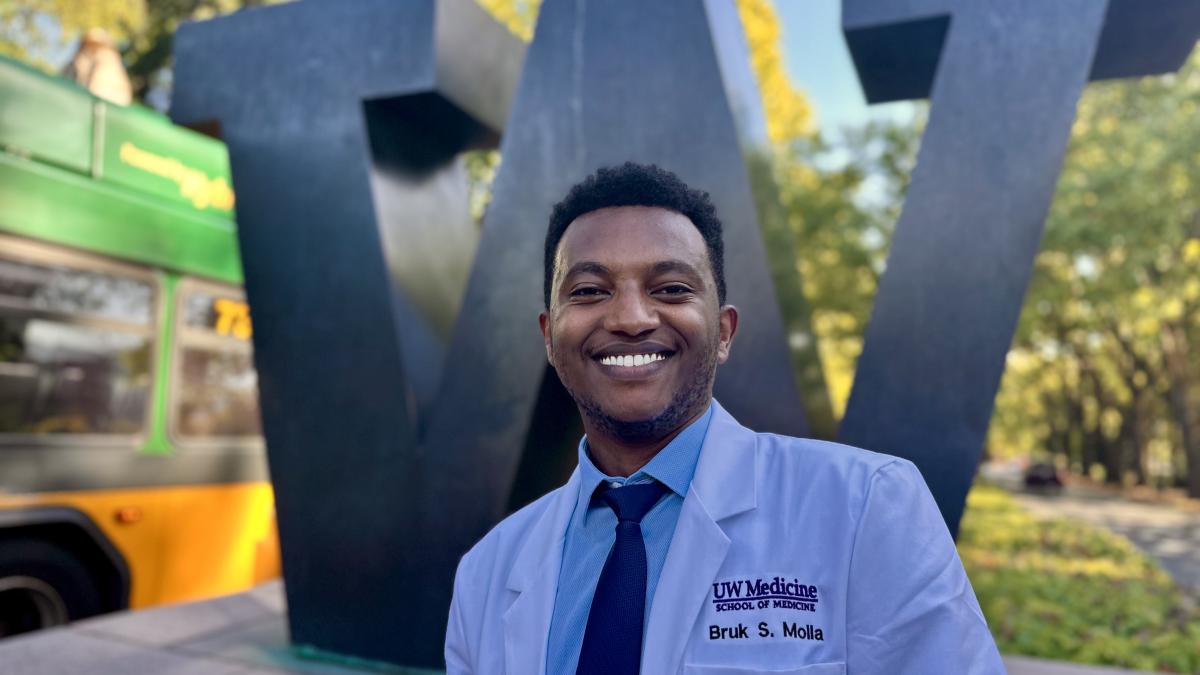When Bruk Molla first came to the UW as an undergraduate, he was searching for the perfect premed major. He considered several options, but struggled to find exactly what he was looking for: a field with direct impact on people’s lives. Then he discovered the Environmental Health major in the Department of Environmental & Occupational Health Sciences (DEOHS).
“It was one of the most health-applicable things I could major in and still incorporate the premed requirements,” he said. “I thought, this is the perfect major for me as a premed student. It prepared me for medical school and gave me a bigger lens going forward.”
Molla, now a first-year medical student at UW, says his research, classwork and internship experiences in DEOHS all set him up well for medical school and launched him on a path toward becoming an academic physician.
The small, close-knit department, where, he said “everybody knows everybody,” made it easy for him and fellow majors to get experience in research.
Working in the lab of Associate Professor Julia Yue Cui on gut health gave him insights into how to conduct basic research and how to critique research papers. The experience has already come in handy in his first weeks of medical school.
“Research is an unwritten required thing that you need to be doing in medical school, so it’s always good to have experience in that under your belt going in,” he said.
“I like environmental health research because it has a direct impact on people’s lives. It’s hands on: you can do something and see the result right away.”
- Bruk Molla
A broad palette
The major is broad enough that students can choose to focus on areas that most interest them, Molla said. He especially enjoyed classes on occupational health and safety, children’s environmental health and antibiotic resistance, which were all “applicable to medicine as well as public health,” he said.
Additionally, he was impressed by the DEOHS faculty: “The professors are amazing and very knowledgeable, and most are doing their own research,” he said. “They and the advisers in the department are really good about helping students.”
In one of Molla’s most memorable classes, he learned about radiation safety through the lens of the Chernobyl disaster. The experience has inspired one of his main interests so far in medical school: interventional radiology.
Exploring radiology
In interventional radiology, healthcare providers perform surgical procedures guided by images including X-rays, CT scans and MRIs. For example, during a procedure to remove a clot from a patient’s brain, they might use X-rays called angiograms to image blood vessels.
Not only is Molla interested in practicing this kind of medicine, but his occupational health background has also inspired him to pursue quality control research to ensure the safety of those performing the procedures.
“We tend to focus on patients’ health and safety, but not as often on the people providing the care,” he said. “It’s a mind-frame shift I’ve had after taking classes in environmental health.”
Reaching underserved populations
For his required internship as an Environmental Health major, Molla chose to work with the Northwest Pediatric Environmental Health Specialty Unit (PEHSU) on a project promoting safer cleaning practices for families at home.
Molla led trainings in English and Amharic for community health workers in King County, incorporating culturally inclusive comics developed by PEHSU in collaboration with the American Academy of Pediatrics.
As an immigrant from Ethiopia, Molla says he chose the project because of his interest in working with underserved populations, something he hopes to continue throughout his career.
“Many health issues that still exist in our medical system today are based on research that mostly doesn’t reflect underserved populations,” he said. “We have the responsibility to dismantle that. Any chance I get to incorporate underserved population perspectives, I’ll try to do that.”




